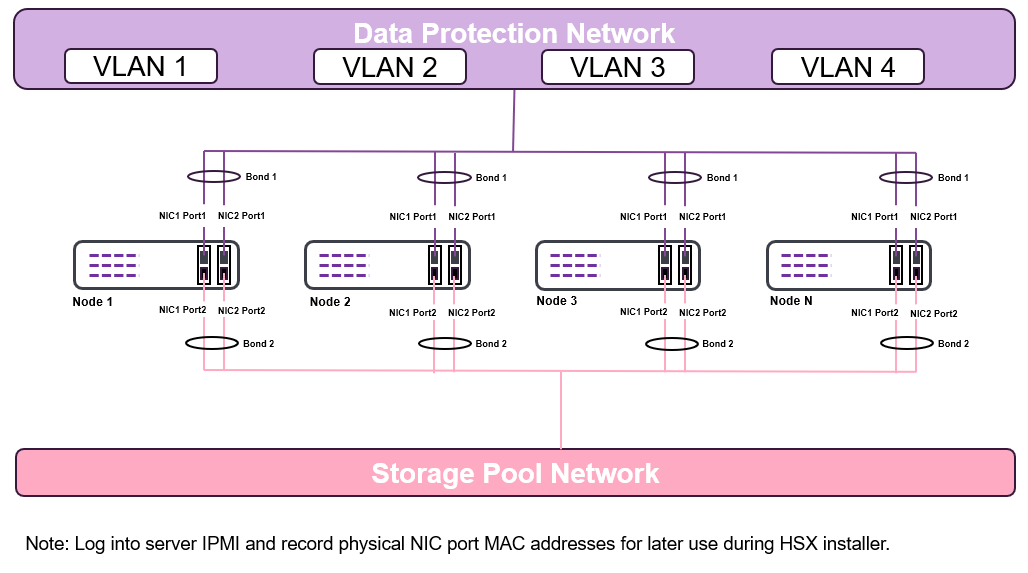This topology allows multiple tagged VLANs to connect to the appliance using the bonded data protection interface. This allows connection to multiple non-routable networks used to avoid sending backup traffic through a router or firewall.
In this topology, each node requires the following connections:
-
2 - 10 GbE bonded ports for data protection which will connect to multiple tagged VLANs to transfer data to and from the clients being protected and connect to the CommServe server. This will include connections to:
-
2 or more VLAN IDs
-
2 or more IP addresses based on the number of VLANs
One of the VLANs must remain routable to connect to the CommServe server.
-
-
2- 10 GbE bonded ports for storage pool which is a dedicated private network, used for communication and replication between the HyperScale nodes.
VLAN interfaces cannot be configured on the storage pool interface.
Note
VLAN topology connects multiple VLANs directly to the HyperScale X Reference Architecture nodes over a single physical connection. This is typically used to connect directly to different networks to avoid traversing routers or firewalls that can become a bottleneck, or to connect to isolated networks. This can be combined with the bonded configurations to provide redundancy using either the Active-Backup bonding or the Link Aggregation Control Protocol (LACP). This can also be used with a multi-switch link aggregation protocol such as Virtual Port Channel (VPC), MLAG, or MC-LAG to provide switch level redundancy.

-
Each pair will be bonded on the node, so it is treated as one logical connection. If a node encounters a cable, SFP, or network card failures, the node remains operational without any user intervention. This can optionally be setup to connect to 2 switches to provide switch level redundancy.
-
Active-Backup and Link Aggregation Control Protocol (LACP) are the supported bonding modes.
LACP requires the switch(s) to support it as well. When using LACP, each pair of ports should be configured as an active port-channel, and not configured to negotiate the aggregation protocol.
Network Requirements
In this topology, the number of IP addresses required depends on the number of VLANs. For example, if you have 3 VLANs, 10, 20 and 30, you will require 3 IP addresses per node, as follows:
-
2 - 10 GbE bonded ports connected to the VLAN IP addresses for each of the VLANs used for data protection.
Out of the available VLANs, one network should be routable and the other network(s) must be non-routable. The routable network will be used for CommServe server registration, in addition to data protection operations. All the other VLANs will be used exclusively for data protection operations.
-
2 - 10 GbE bonded port for the storage pool which is a dedicated private network, used for communication and replication between the HyperScale nodes. This requires a corresponding IP address for the storage pool network.
Note
Data Protection and storage pool networks MUST be on two separate subnets.
The following network names and IP addresses are required for this topology:
|
Node 1 |
Node 2 |
Node 3 |
Node n |
|
|---|---|---|---|---|
|
Data Protection Fully Qualified Domain Name* |
|
|
|
|
|
Data Protection vLAN Address* |
|
|
|
|
|
Data Protection Netmask* |
|
|
|
|
|
Data Protection Gateway* |
|
|
|
|
|
Data Protection DNS 1* |
|
|
|
|
|
Data Protection DNS 2 |
|
|
|
|
|
Data Protection DNS 3 |
|
|
|
|
|
Storage Pool IP Address* |
|
|
|
|
|
Storage Pool Netmask* |
|
|
|
|
|
Data Protection NIC Port 1 Card 1 MAC Address |
|
|
|
|
|
Data Protection NIC Port 1 Card 2 MAC Address |
|
|
|
|
|
Storage Pool NIC Port 2 Card 1 MAC Address |
|
|
|
|
|
Storage Pool NIC Port 2 Card 2 MAC Address |
|
|
|
|
* Required fields Each node should be resolvable to the CommServe server. The following information is required for the vLANs. (The following section is provided with examples for illustrative purposes. Replace them with the appropriate IP addresses in your environment.)
|
vLAN1 |
|
|
|
|
|---|---|---|---|---|
|
vLAN1 Description |
Infrastructure |
|
|
|
|
vLAN1 ID |
10 |
|
|
|
|
vLAN1 Address |
172.16.10.101 |
172.16.10.102 |
172.16.10.103 |
|
|
vLAN1 Netmask |
255.255.255.0 |
|||
|
vLAN2 |
|
|
|
|
|
vLAN2 Description |
Marketing |
|
|
|
|
vLAN2 ID |
20 |
|
|
|
|
vLAN2 Address |
172.16.20.101 |
172.16.20.102 |
172.16.20.103 |
|
|
vLAN2 Netmask |
255.255.255.0 |
|||
|
vLAN3 |
|
|
|
|
|
vLAN3 Description |
Sales |
|
|
|
|
vLAN3 ID |
30 |
|
|
|
|
vLAN3 Address |
172.16.30.101 |
172.16.30.102 |
172.16.30.103 |
|
|
vLAN3 Netmask |
255.255.255.0 |
Note
If you have more than 3 nodes expand the columns in this table to include all the nodes that you plan to setup.
Similarly. depending on the number of vLANs in your environment, add rows to include the information for all the vLANs.
CommServe Requirements
You will require the following information to connect to an existing CommServe server:
|
CommServe hostname (FQDN) |
Fully qualified hostname (FQDN) associated with the existing CommServe server. Note TCP Ports 8400 & 443 must be open from the nodes to the CommServe server. |
|
Username |
Username associated with the admin user. |
|
Password |
Password for the admin user. |
